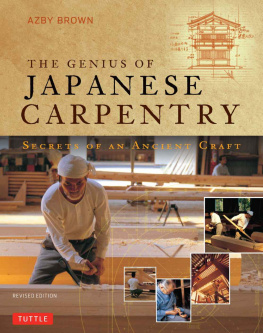JAPANESE WOODWORKING
A Beginners Guide to the Art of Japanese Joinery and Carpentry
By Sean Graham
Copyright 2021 - All rights reserved.
The content contained within this book may not be reproduced, duplicated or transmitted without direct written permission from the author or the publisher.
Under no circumstances will any blame or legal responsibility be held against the publisher, or author, for any damages, reparation, or monetary loss due to the information contained within this book. Either directly or indirectly.
Legal Notice:
This book is copyright protected. This book is only for personal use. You cannot amend, distribute, sell, use, quote or paraphrase any part, or the content within this book, without the consent of the author or publisher.
Disclaimer Notice:
Please note the information contained within this document is for educational and entertainment purposes only. All effort has been executed to present accurate, up to date, and reliable, complete information. No warranties of any kind are declared or implied. Readers acknowledge that the author is not engaging in the rendering of legal, financial, medical or professional advice. The content within this book has been derived from various sources. Please consult a licensed professional before attempting any techniques outlined in this book.
By reading this document, the reader agrees that under no circumstances is the author responsible for any losses, direct or indirect, which are incurred as a result of the use of information contained within this document, including, but not limited to, errors, omissions, or inaccuracies.
Table of Contents
INTRODUCTION
Japanese woodworking is a bespoke cultural form of carpentry developed in Japan. In its simplest form, it can be explained as a technique whereby all additional materials associated with modern carpentry, such as nails, screws, and adhesives, are dismissed in favor of meticulous joints forming part of each element of a particular project.
The practice saw its origin in China but found its way to prevalence in the fervent adoption upon its introduction to Japan. Since then, the skills were fine-tuned, revised, and built upon to become the unique and distinguishable practice we see today.
Those less familiar with Japanese woodwork may think it odd that so much emphasis is placed on the joints that connect parts of a project. Many would argue that this is a minor difference, particularly in an age where large structures are no longer commonly produced from wood, with builders favoring brick and concrete.
The relevance of this ancient art form does admittedly appeal to a niche market, but the artistry that sees Japanese woodwork remains relevant in the highly skilled artisan world. While the complex joints could arguably be machined with relative ease, the fact that this is not considered 'true' Japanese woodwork speaks to the more refined appreciation it enjoys amongst aficionados.
A large part of the appeal to those passionate about woodwork is the level of dedication required to master the practice. While carpentry, as we know it in the west, is by no means unimpressive or easy to master, these skills must be honed to an unprecedented degree to truly master the precision required to construct these joints that adhere utilizing friction and fit alone.
If your interest is piqued, don't let the information and descriptions provided above dishearten you. Indeed, Japanese woodwork is not a skill easily mastered, but it is certainly worth the time and dedication to those interested in the craft.
This detailed and high-precision work necessitates the use of tools that allow for said precision. To achieve this, the Japanese woodworker will spend a lot more time ensuring that their tools, chisels, and the like, are maintained and sharpened. We will explore these tools in the chapters to follow.
There's a high level of care taken when creating pieces that exceed the standards of most western carpentry, down to the absurdly precise angles and incisions used to make the nearly seamless joints characteristic of this style. The aversion to using nails and screws has survived their advent because they are considered 'harsh' implements.
The perfectly crafted joints of Japanese woodworking do no damage to the wood, making for a more resilient final product. Think of these joints as three-dimensional jigsaw puzzles that the carpenter creates to form different pieces of woodwork. Or something like a Tetris game of woodworking. The first time you come across this form of carpentry, these intricately designed joints stand out the most.
For projects that need to be a bit sturdier, a hole might be carved through the wood to accommodate a wooden peg. One will often see this in buildings and other large structures that traditional Japanese carpenters have built. This technique of using a peg as part of the fixing is still within the philosophy, so to speak, of Japanese woodworking despite it destroying the wood. This is because it depends on the same method of construction: friction.
It is in the larger constructs that we find the most impressive examples of Japanese carpentry. To witness an entire building constructed exclusively of wood, with no additional tools or materials used as fixings, is an impressive sight. Returning then to the primary question at hand: Is this skill for you? As mentioned, if you are passionate about carpentry and want to take on the challenge, your patient practice will be well rewarded.
You could also be wondering whether Japanese woodworking still holds relevance outside the purely fanatic niches? For the hobbyist, this answer is quite easy. Learning the craft will not only open up new avenues of carpentry for you to explore. But you will undoubtedly improve your woodworking skill by adopting the precise and delicate hand required for Japanese woodwork.
For the professional woodworker, the best reason you should master this art is that although it may not enjoy as much commercial success as it once did, the standard prices for commissions are quite attractive, given the rarity of master craftsmanship.
This book will explore the entirety of Japanese woodworking to make it as accessible and easy to understand as possible while not compromising the information provided to you. Some techniques and principles included here range from novice to advanced levels. This mixture of skill levels is done to give you a clear picture of the scope of Japanese woodworking. Regardless of how far you hope to take your skill level, this book will provide you the information you need to grow your craft.
Let's get into it.
Chapter One: Origin of Japanese Woodworking
Japanese-style carpentry is believed to have originated roughly a millennium ago with deep roots in China. The technique was adopted by Japanese nationals returning from visits to the Tang dynasty. In the centuries that followed, particularly a time known as the Muromachi period, there was an upsurge in demand for carpentry skills.
The advent of tea ceremonies and the cultural significance that they enjoyed significantly impacted the Japanese carpentry scene. Professional carpenters now benefited from a newly-found demand for constructs like storage boxes, display cabinets, and tea containers. During the Edo period, Japanese rulers allocated specific tasks to each town. The effect was that one settlement would be focussed primarily on just one primary skill, for example, blacksmithing or carpentry.
The nuanced practice centered around the principle of wood joinery saw critical development between the 17th and 19th centuries. This practice was known as Edo Sashimono. The economic driving force behind the practice was facilitated by increased interest from Samurai families, wealthy merchants, and successful performers.



















